#klondike gold rush national historic park
Explore tagged Tumblr posts
Text



























The founding of Seattle is usually dated from the arrival of the Denny Party on November 13, 1851, at Alki Point.
#Seattle#founded#Denny Party#anniversary#US history#Public Market#Washington#Puget Sound#Pacific Ocean#USA#original photography#summer 2012#architecture#cityscape#International Fountain#Pike Place Market#Space Needle#Frank O. Gehry#Museum of Pop Culture#Seattle Mural#Smith Tower#Pioneer Square#Pacific Northwest#13 November 1851#Klondike Gold Rush National Historical Park#travel#vacation#tourist attraction#landmark
12 notes
·
View notes
Text
Skid Row: A Seattle Original
Many young people know Skid Row only as the seminal heavy-metal band most famous for its 1989 hit Youth Gone Wild. They remain blissfully unaware that the term originally referred to the most down-and-out section of cities across America. Skid rows are known to be the home of the poor, the dangerous, the failed, and the hopeless-and the very first of these areas was found in Seattle.
The original skid row of Seattle was Yesler Way, which gained its curious nickname because Henry Yesler used the street to skid logs to his waterfront sawmill. This term was used in logging camps in the early 1800s, but its meaning changed when attached to this street in Seattle. An abundance of transient homeless people had come to settle there, and the label came to be more associated with them than it did with logs. During Prohibition, a popular clergyman named Mark Matthews began preaching against the dangers of such neighborhoods, and he is generally credited with spreading the definition of skid row to mean "bad neighborhood" as opposed to "logging route."
Over time, skid row came to refer not just to Yesler Way but also to the entire Pioneer Square area. For many decades, this vicinity was known as the stomping ground for Seattle's homeless population. With no laws against begging and a backed-up social welfare system that made fraud relatively easy, it was a lawless land where the tramp was king.
A 1986 New York Times article detailed what the author found upon visiting Seattle's skid row:
. . . men slumped on park branches, oblivious to the signs of the gathering storm that would drive them to shelter. When approached by a reporter, they mumbled requests for money.
A man who called himself Bill huddled, shaking with violent chills, his crutches beside him in a doorway where he begged for money for a pint of wine because "I can sleep in the parking garage if I have some wine to keep me warm."
Gentrification has turned modern-day Pioneer Square into an area full of Internet cafés, coffee shops, and art galleries. It's also officially a part of the Klondike Gold Rush National Historic Park.
Seattle's skid row has been many changes since its days as a logging road. Today, it's a hip trendy, revitalized area-but for the bulk of its existence, it set the standard for skid rows across the entire country.
Underground Beneath Seattle's Skid Row
Seattle's original grunge movement had nothing to do with music; it was all about living in the dark depths below with the eyes can see.
In 1889, the Great Seattle Fire spread through most of the city, destroying the bulk of its business district. While the devastation was severe, rebuilding presented a unique opportunity for improvement. Since the Pioneer Square area had been built upon tidelands, it often flooded, so city officials decided to rebuild it on a more elevated level than its previous incarnation. Unfortunately, restless business owners began rebuilding before the city had a chance to start its renovations, and the owners built at the old-lower-street level.
Nevertheless, it was decided to build the city up higher, but without shutting down what lay below. This meant that when the newer higher version of the neighborhood was completed, some sidewalks and storefronts were as deep as thirty-six feet beneath it. Visitors descended ladders to the lower-level streets and stores until a series of entrances was built to grant access to the subterranean section of town. Officials eventually condemned the underground city on the grounds that it was a breeding pit for any number of diseases, particularly bubonic plaque. For decades, the underground sat unused, just beneath the surface of the very active Pioneer Square.
Starting in the 1960ds, local entrepreneurs began running a tour of the netherworld city, appropriately named the Underground Tour, which has become a popular family activity. Recently your organizers began offering the Underworld Tour, an adult version of the tour, which speaks frankly about the subterranean area's use by drug and prostitution kingpins.
Penny Truitt, a tour guide of Seattle's underbelly, showed us around when we visited. She filled us in on the day-to-day routine of splitting time between the above- and belowground worlds.
"The city figured the solution was just to put a ladder at the corners, and that's how you would cross the street. Without dropping the kids, your packages. It was miserable," Penny told us. "And for men in Seattle, you know, these were loggers, and they're either chopping or partying." We asked her what the results were of having a heavily drinking portion of the population climbing up and down ladders all day. "Seventeen guys didn't make it," she said. "Seventeen men fell from the street to the sidewalk. They say the cause of death was involuntary suicide."
Penny also filled us in on some of the less legitimate activities that took place down in the deep. "Seattle is a Wild West town," she said with a hint of pride. "I mean, we're on the coast, how much more frontier can you get?" To serve certain segments of the population, Seattle had a large quantity of "sewing girls," as they called themselves. Or as Penny puts it, "We'll just say that's what the girls told the cops when they were arrested."
How large was the problem? "At one point, about ten percent of the population claimed to be working as, ah, seamstresses," Penny admitted. "Over two thousand seamstresses, all but six living in the same three-block area."
These days the underground version of Pioneer Square still stands, although public access is limited. Rumors swirl that it has become a de facto home for Seattle's homeless population, especially during bad weather. No word on whether the sewing girls are still stitching britches.
0 notes
Text
Amazing Adventures - Alaska
This blog post shares UPDATED Travel Destination Guide: Amazing Adventures Alaska. Here discover the highest mountain in North America, railways, ice museums and so much more. Let's travel Alaska style!
Hello and welcome to my UPDATED Travel Destination Guide: Amazing Adventures – Alaska. Come explore with me and discover the highest mountain in North America. Aurora’s Ice Museum/Bar/Hotel and so much more. Let’s travel Alaska style. Mountains and Glaciers and Trains – Alaska The Denali Mountain range (formerly known as Mount McKinley) is the highest mountain peak in North America. The summit…
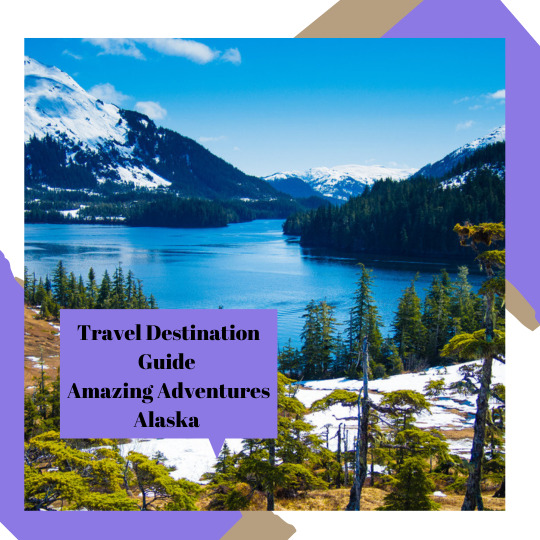
View On WordPress
#A Few of my Favorite Things#Alaska Lifestyle#Amazing Adventures#Amazing Travel#Amazing Travel Adventures#Aurora Ice Museum#Denali Mountian#Glacier Bay National Park and preserve#Klondike Gold Rush#Klondike Gold Rush National Historic Park#Mount McKinley Mountain#New Blog Post#Riverboat Discovery Tours#Things to do in Alaska#Travel Adventures#Travel Destination Guide#White Pass & Yukon Route Railway
0 notes
Link
1 note
·
View note
Photo
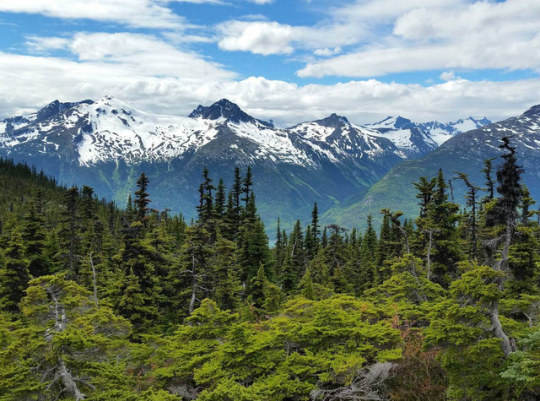
In the last four years of the 19th century, over 100,000 prospectors flooded into the Klondike region of Alaska and Canada looking for gold. Klondike Gold Rush National Historical Park not only tells the stories of these pioneers, it preserves 13,000 acres of historic sites and stunning wilderness. Traveling the trails is like going back in time. Photo by C. Anderson, National Park Service.
#klondike gold rush#klondike goldrush national historical park#national park service#nps#find your park#findyourpark#Alaska#usinterior#history#nature#nature photography#landscape#landscape photography#trees#mountains#Forest#wilderness#amazing view#awesome experience#gorgeous scenery#outdoors#great outdoors#america's great outdoors
1K notes
·
View notes
Text

Historic photo from Pioneer Square about 1897 (NPS Brochure on the Gold Rush Museum)
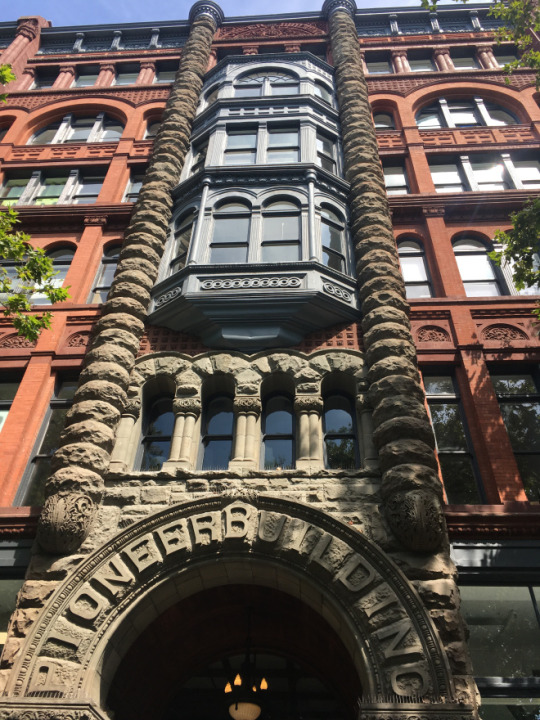
Pioneer Building at Pioneer Square. 48 mining firms flourished here because of the Gold Rush
Pioneer Square close to the harbour in Central Seattle contains many historic buildings. I was glad that we managed to go to the Klondike Gold Rush Museum. The exhibition was engaging as you followed different historical persons who took part in the gold rush or earned money on equipment for the journey to Alaska.
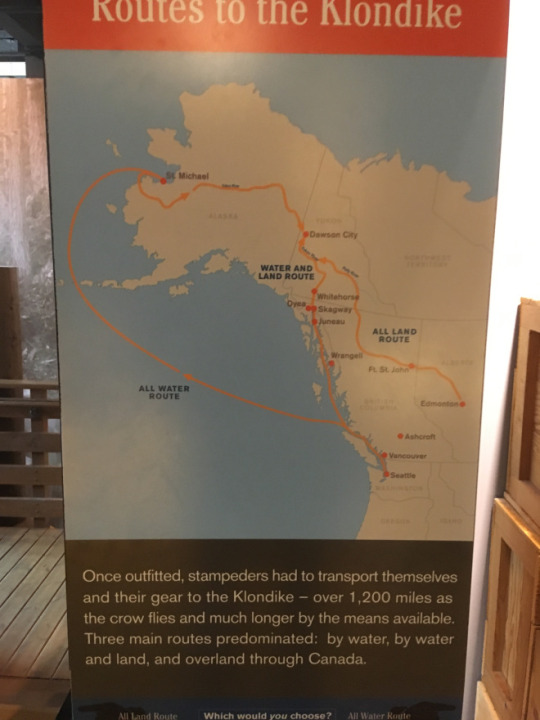
Routes to the Klondike by water, by water and land and overland through Canada
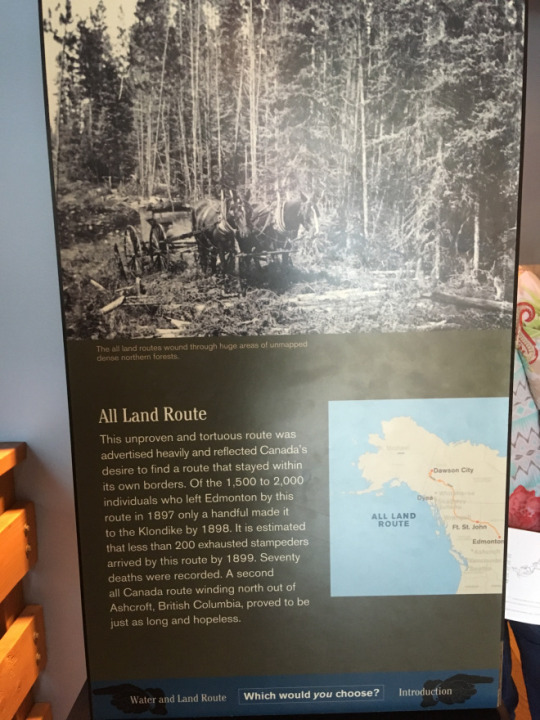
A picture showing the land route to Yukon, Alaska
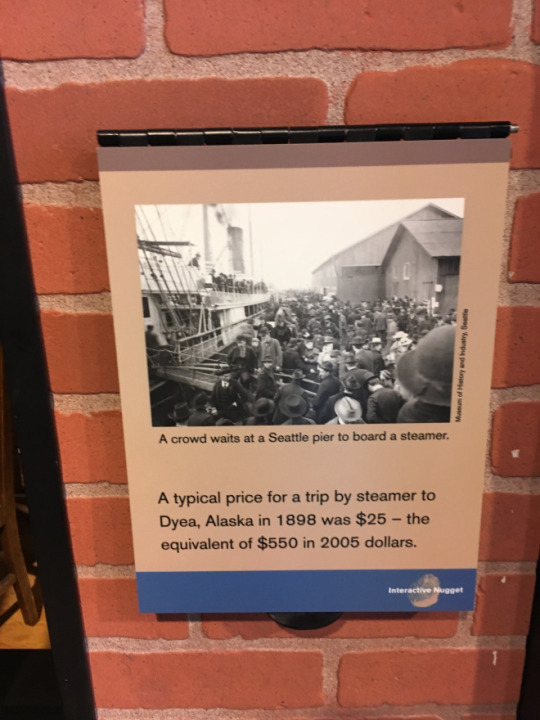
A crowd waiting to board a steamer

From a brochure: The Klondike Gold Rush Museum in Historic Cadillac Hotel at S Jackson and 2nd Av, Seattle

Exhibition case at the Gold Rush Museum
Advertisement for buying mining equipment at Cooper & Levy
Mining the Miners. Get everything you need at Cooper & Levi
A supply list for your mining equipment
A supply list for your mining equipment
Exhibition case at the Gold Rush Museum
Get your Klondike gear here at the lowest price
Very few people got rich from digging gold. It was already over when the big rush arrived.
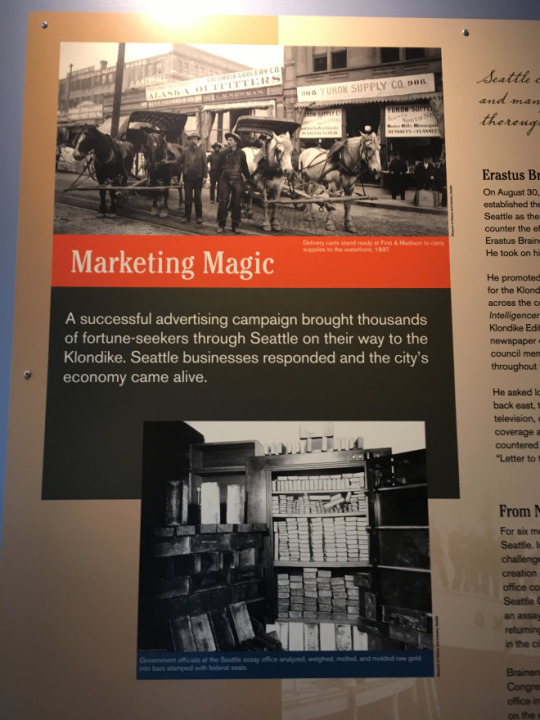
Photos showing shops for gold mining equipment and a government office making gold bars.
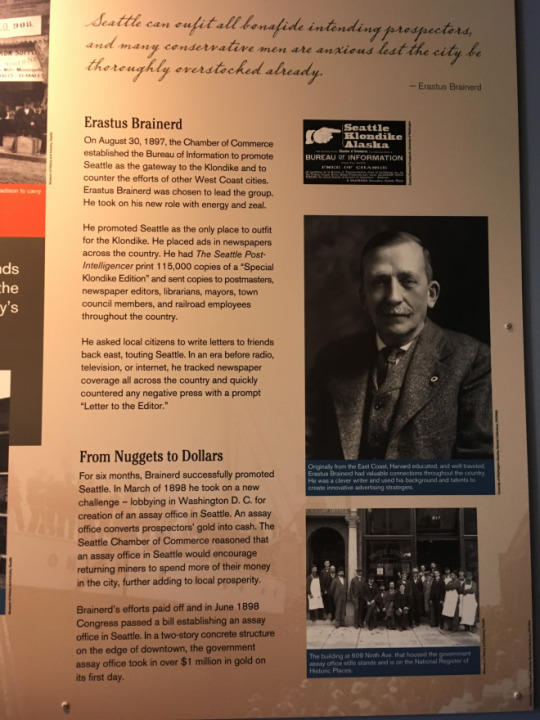
Erastus Brainerd promoted Seattle as a gateway to the Klondike.
Two men stood out to me. One was Erastus Brainerd who understood the value of the advertisement. Seattle was not the most obvious way to chose to go to Alaska, but he travelled all over the United States and succeeded to guide people to go to Seattle to buy the equipment for the challenging journey. From the Klondike Goldrush Museum’s Homepage:
Seattle merchants quickly exploited their port status. Advertisements far and wide declared Seattle as the “Gateway to the Gold Fields” – the place where all one’s Klondike needs, from food and warm clothing to tents and transportation-could easily be fulfilled. As a result, some 30,000 to 40,000 of the estimated 70,000 stampeders, who outfitted to go to the Klondike, bought their “ton of provisions” in Seattle. The city prospered.
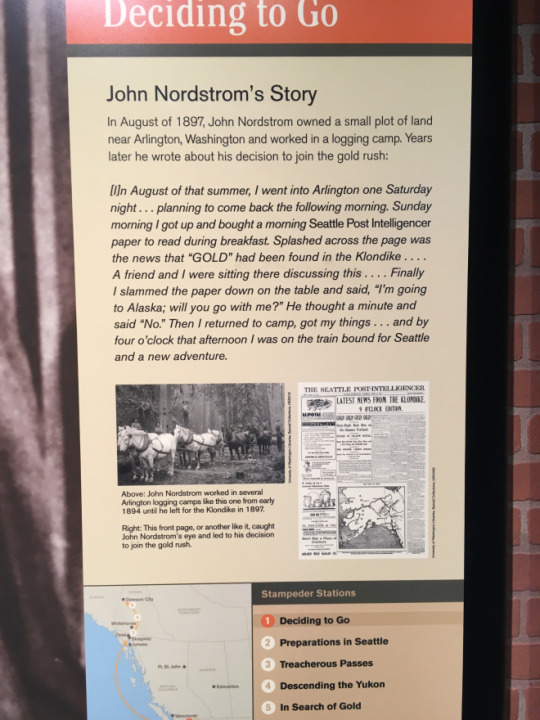
Swedish John Nordstrom’s story from working at a logging camp to becomig a gold miner.
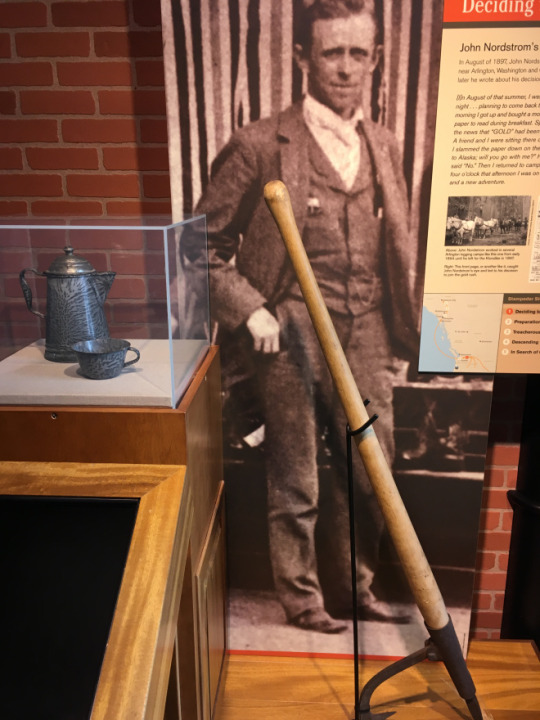
A photo of John Nordstrom
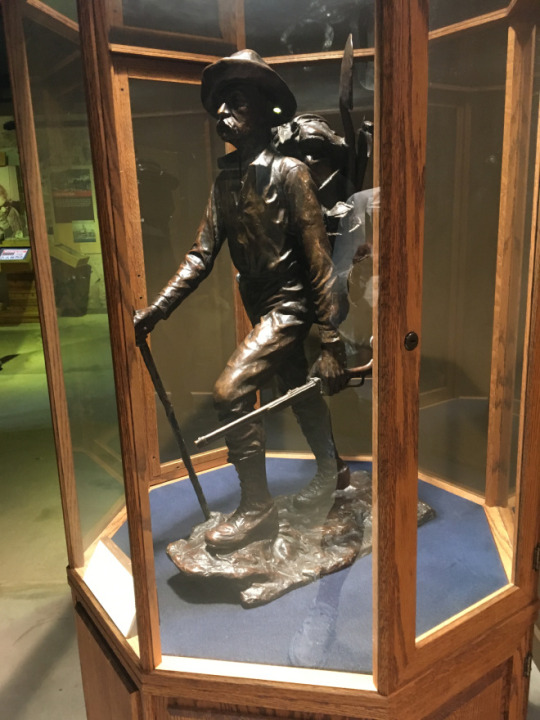
Bronze statue of a gold miner at the Gold Rush Museum
John Nordstrom, a young man from Sweden who at the age of sixteen in 1887, left his homeland to start a new life in the USA. One day at work in 1897, he read about the Gold Rush and decided to go the next day. He did earn some money from gold-digging but sold his part due to a dispute and started a shoe shop with someone in Seattle.
Nordstrom’s shoe shop developed into a department store that still flourishes in many places in the Western part of the United States. I later enjoyed shopping in Nordstrom’s in Portland, Oregon. His store is known for high customer service.
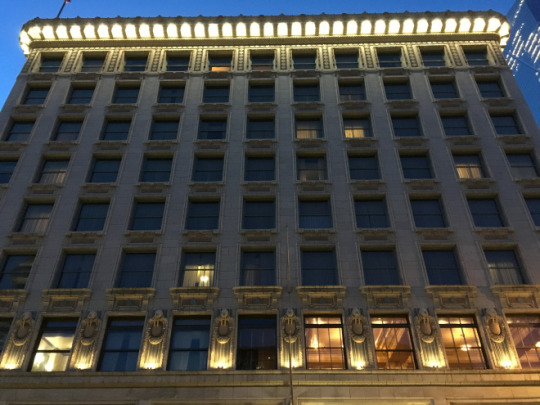
The Arctic Club Building Seattle Landmark. Contractor Hans Pederson
I have a blogging friend Paula Pederson whose father Hans Pederson from Denmark (1865-1933), was one of the great builders of Seattle at the same time as John Nordstrom. Before Hans Pederson found his destiny in the building business, he nearly lost his life in the gold rush. You can read more about him on Paula’s blog and the book she wrote about him. He got his breakthrough in 1904 with the contract to plaster the Alaska Building.
From Hans Pederson’s obituary:
“He was among the first to answer the call of the North when the manhood world stampeded toward the artic and the sparkle of gold.”
Few women and children made it to the Yukon area in Alaska. Ethel Anderson was born in Bellingham, WA but spent her first six years in a cabin on Eldorado Creek in Yukon.
She later achieved to gather treasure of long-forgotten photographs from the adventure.

Ethel Anderson managed the harsh journey to Yukon with her mother and a sibling. Her red coat is on display
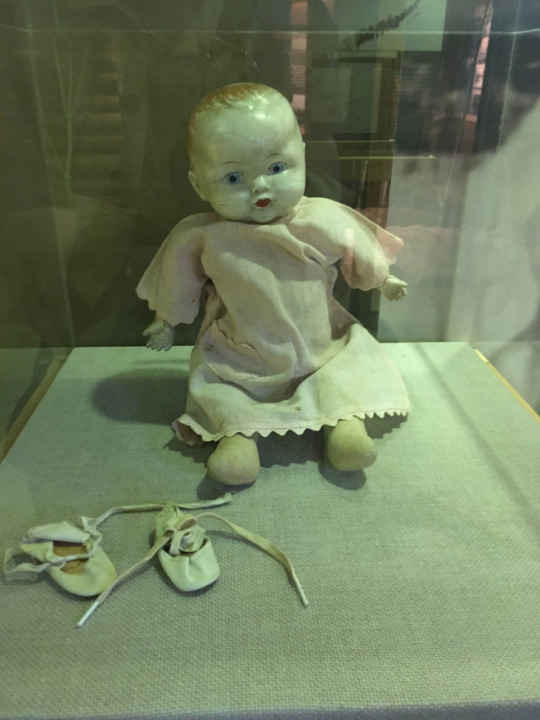
Ethel Anderson’s doll from her early childhood in Yukon
The Klondike Gold Rush Museum in Seattle Pioneer Square close to the harbour in Central Seattle contains many historic buildings. I was glad that we managed to go to the Klondike Gold Rush Museum.
0 notes
Text
Sunday 9th October cont’d
We then went to the ‘Gold Rush National Historic Park, that is actually in a building. It was a display about the Klondike Goldrush in the early 1890’s and Seattle’s part in that. A large proportion of those involved started their journey in Seattle and either travelled by ship through the inside passage to Skagway or nearby Dyea.and then travelled overland, or the richer folk went by ship all the way to St Michaels in western Alaska and a shorter journey. 300,000 people attempted to reach the Klondike but only 20000 succeeded but only 3000 made any appreciable money out of it. The displays linked in with the displays we saw in Skagway.
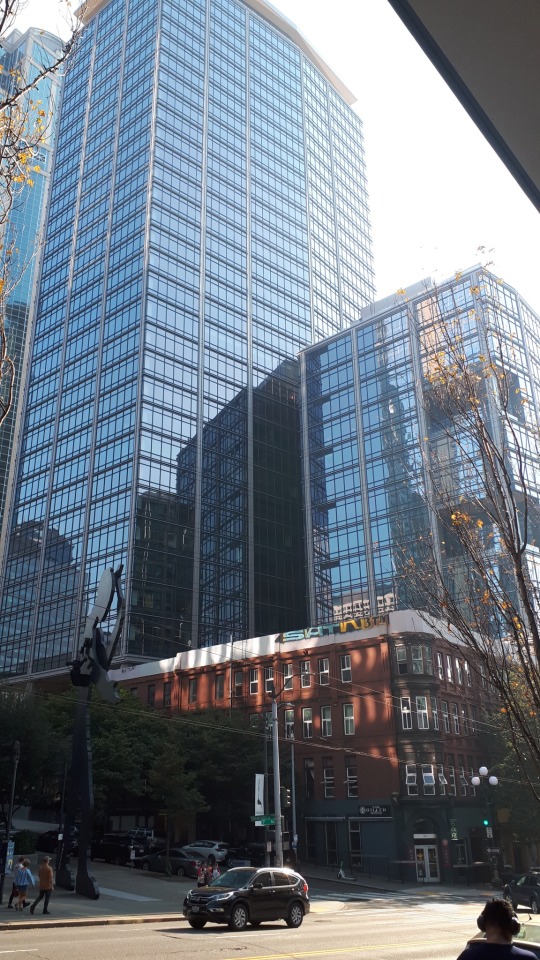
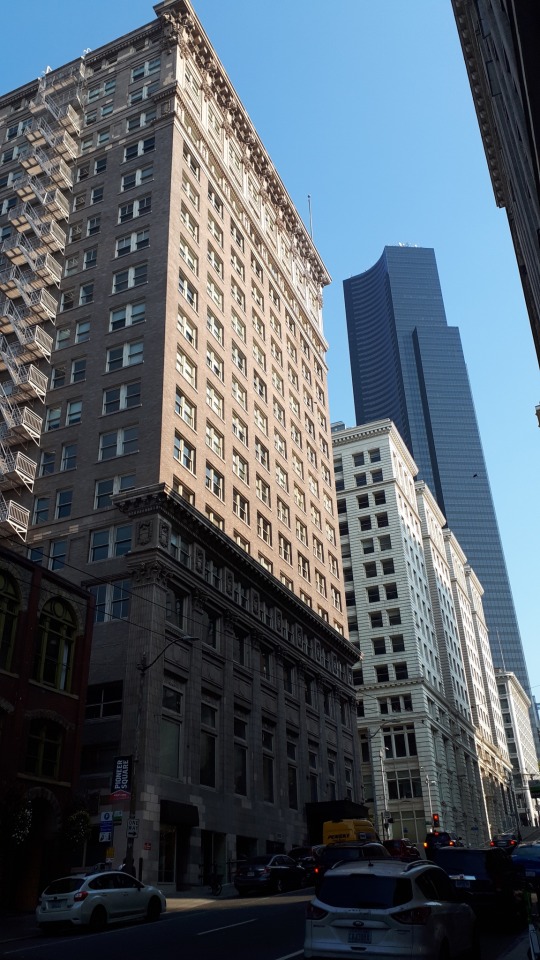
4 notes
·
View notes
Photo

Our artist of the day is @cassandralkim! We just released these two awesome small works in honor of her day. Cassandra Kim is a contemporary artist whose paintings reflect a lifelong love of animals and traditional art. Inspired by the master painters of the past and she seeks to put her own slightly absurd surrealistic twist on art by replacing animals with people. She also has been teaching herself to restore reclaimed antique and vintage wood items to paint on or frame her paintings in. She is a Virginia native and 2003 BFA Illustration graduate from Virginia Commonwealth University, and worked as a muralist and graphic artist for Trader Joes for 14 years. In 2013, the Klondike Gold Rush National Park and Chilkoot Historical Site awarded Cassandra with an artist residency. In 2018 Cassandra turned her focus to her personal art full-time. She has been in exhibits across the United States and internationally. #meartistoftheday #mesummertour https://www.instagram.com/p/Cf4Fl3hrtbf/?igshid=NGJjMDIxMWI=
2 notes
·
View notes
Photo

It is an honor, every year, to walk in the Seattle Pride Parade, spreading the message that "Parks are for Everyone!" We've been sidelined for two years due to the Pandemic, but this year's event was colorful, chaotic, and joyful, with huge crowds both marching in the parade and watching from the sidewalks on a hot, sunny day. Mount Rainier National Park's contingent was joined by rangers and volunteers from Olympic National Park, Klondike Gold Rush National Historical Park - Seattle, WA, the NPS Seattle Support Office, and Olympic National Forest. We handed out #RangerPride stickers to hundreds of people and were cheered enthusiastically all along the route. See for yourself! Photos are at https://flic.kr/s/aHBqjzW5J5.
Next up is the Eatonville 4th of July Parade! As always, volunteers are welcome to join us in representing Mount Rainier National Park in this gateway community. If you'd like to walk with us at noon on July 4th, please RSVP to [email protected] for details.
#Seattle Pride#PrideFest#Mount Rainier National Park#volunteer#Ranger Pride#Olympic National Park#Klondike Gold Rush#Olympic National Forest#US Forest Service
2 notes
·
View notes
Text










Skagway, AK (No. 5)
Martin Itjen's House. Broadway between 1st Avenue and 2nd Avenue. The building serves as the NPS and Parks Canada Trail Center, and is one of the first structures visitors to the park arriving by ship see. Originally it stood on piers by the wharf, completed in 1902, and is reminiscent of homes built for railway employees. In 1922, it was sold to Martin Itjen who had learned to profit from the summer tourist trade by greeting passers-by and selling tours of the town's attractions. Relocation of railway tracks in 1946 isolated the house, which after two intermediate moves ended up on Sixth. NPS acquired the structure in 1978, moving it to its current position 300 feet (92 m) west of its original location. Restoration was completed in 1991 to return the home to the 1921-1941 period.
Verbauwhede's Cigar Store, Confectionery, and Cribs. Broadway between 2nd Avenue and 3rd Avenue. Frederick Verbauwhede originally opened a store selling cigars and confections here in 1898, and in 1902 moved one-story "cribs" behind the store from their previous location between Fourth and Fifth where they housed prostitutes. A gunsmith, jeweler, gas station and travel agency occupied the premises at one time or another through 1977 when NPS purchased the buildings. Restored in 1986, the cigar store is leased to a private business while the cribs are used by the park's law enforcement operations.
Boas Tailor & Furrier Shop. Broadway between 2nd Avenue and 3rd Avenue. As the name implies, it was formerly, though briefly, a furrier, topped by a traditional high wooden false front as seen in other western towns in the United States and Canada. After a series of other business, it was sold to NPS in 1978 with period restoration completed in 1986. It is now leased to private business to encourage a feeling of Skagway as a center of bustling business activity.
Source: Wikipedia
#Boss Bakery#Goldberg Cigar Store#Alaska#travel#original photography#vacation#tourist attraction#landmark#flora#nature#Last Frontier#Alaska Panhandle#Coast Mountains#forest#woods#tree#summer 2023#cityscape#architecture#Skagway#USA#Broadway#Klondike Gold Rush National Historical Park#flower#street scene#Gutfield Residence#Martin Itjen's House
4 notes
·
View notes
Photo
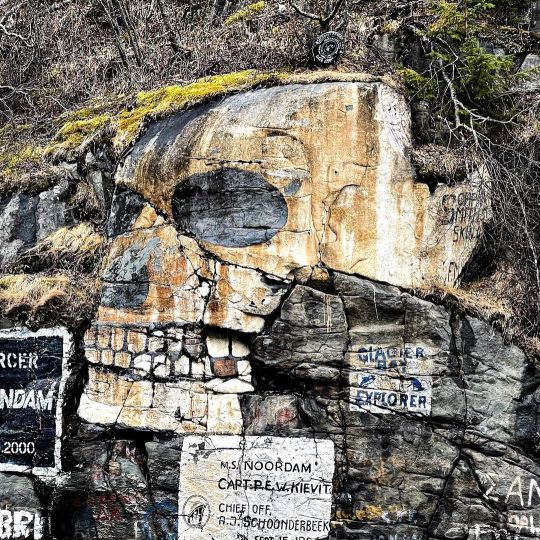
Familiar Faces and Buildings - Return to Skagway, Alaska- Beside the Railroad Dock in Skagway is a cliff upon which are painted the names of ships and when they first arrived in Skagway. This ships' registry has been used to announce the first arrival of ships for over one hundred years. In addition to ship names, there is a large skull painted on the rock face that is labelled "Soapy Smith's Skull." Soapy was one of the original con men and criminals who arrived to prey upon unsuspecting miner in town for the Klondike Gold Rush. Also shown here are details of Arctic Brotherhood Hall, 245 Broadway, Skagway, Alaska. This fascinating façade has nearly 9,000 small pieces of driftwood assembled into a checkerboard design. Camp Skagway No. 1 was a brotherhood of gold speculators and miners. It was established in 1899 when approximately 600 men a day arrived in Skagway by steamers from Seattle. This was the first of eventually thirty camps or brotherhood halls created in Alaska and neighboring Canada. At the peak of the Klondike Gold Rush, membership exceed 10,000 prospectors. -Round Circle is from the door of Alaska's first Y.M.C.A. Circa 1900. Skagway's boom was short lived for this building was closed with the decline of the gold rush in 1901 converted to the Arctic Meat Company and then abandoned. Currently in the process of been stabilized and restored. 5th Avenue and State Street, Skagway, Alaska Source: Klondike Gold Rush National Historic Park, National Park Service, US Department of the Interior, sign on site. & Wikipedia #Alaska #travel #wanderlust #globalgypsy #cruiseship #details #seaman #architecture #godisinthedetails #wandering #details #traveladdict #travelbug #portofcall #traveladdicts #traveladdiction #FotoQuartet #worldtraveladdict #awesome #adventurist #Skagway #adventure #USA #Alaska #SGY #ArcticBrotherhoodHall #CampSkagwayNo1 (at Skagway, Alaska) https://www.instagram.com/p/CdJ9FNVpVhs/?igshid=NGJjMDIxMWI=
#alaska#travel#wanderlust#globalgypsy#cruiseship#details#seaman#architecture#godisinthedetails#wandering#traveladdict#travelbug#portofcall#traveladdicts#traveladdiction#fotoquartet#worldtraveladdict#awesome#adventurist#skagway#adventure#usa#sgy#arcticbrotherhoodhall#campskagwayno1
2 notes
·
View notes
Text
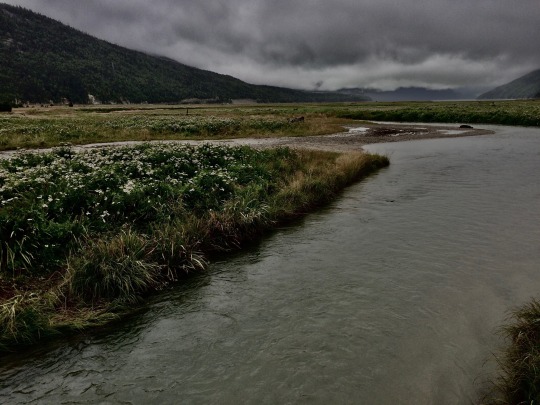


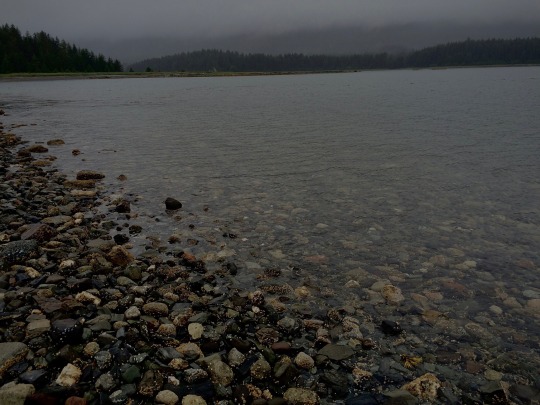
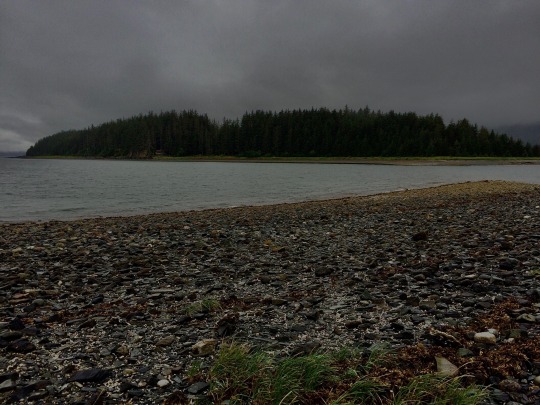
Klondike Gold Rush National Historical Park, Skagway, Alaska. & Colt Island, Alaska.
2 notes
·
View notes
Link
Face Mountain is basking in the beautiful weather today in Skagway -- Klondike Gold Rush National Historic Park
#alaska#scenery#skagway#klondike gold rush national historic park#face mountain#nps#but still there is much that is fair
1 note
·
View note
Text



Why do you want to visit Mount Rainier National Park?
Is it for our fabulous Cascade Concrete, aka snow, so you can slide down the Snow Play sledding run?
Or maybe the wildflowers of July call you to hike the far reaches of the mountain’s sub-alpine parks?
Spring-time waterfalls are enchanting while you drive in the park with stops like Christine Falls.
And how about the park’s stunning historic districts?
*record scratch*
When you think history and National Park Service sites, places like Klondike Gold Rush National Historic Park – Seattle, WA or Ebey’s Landing National Historical Reserve come easily to mind. Mount Rainier has tons of history too. As one of the earliest national parks in the country, Mount Rainier came to define what a national park looks like. The roads, the buildings, the trails, etc. Many of our buildings, some roads, and even a trail or two (like the Wonderland Trail) are on national historic registries.
Preserving our history seems straight forward. Keep the buildings, roads, trails, etc., looking the way they did historically. That job falls on the park’s historical architect and landscape architect. In a way, the landscape architect, through reports and other documents, preserves our history in words. The rest of her job is preserving that history on the land. She makes sure that we keep Longmire, Paradise, the road to Paradise and many other things looking historically correct.
The cultural landscape reports are a big part of that, giving us an ideal to strive towards. Many are available on-line at IRMA (Integrated Resource Management Applications https://irma.nps.gov/Portal/ ) Just search for Mount Rainier and you can find the work and tools of our landscape architects over time. The history and photographs they put into the reports and inventories to protect our historic landscapes is pretty amazing.
Have you stopped and enjoyed the historic landscapes of Mount Rainier? ~ams
NPS/K. Loving Photo (top). View of Christine Falls and road bridge from view point. May, 2017. NPS Photos. Images of front of Longmire Developed Area Cultural Landscapes Inventory, and View and Vista Management Plan. Both available on-line at IRMA.
#encruentra tu parque#find your park#mount rainier national park#mount rainier#history#cultural landscape#landscape architect#NPS#Ebey's Landing NHR#Klondike Gold Rush NHP
35 notes
·
View notes
Photo




Michael J. Heney: The Irish Prince
October 24, 1864- October 4, 1910
The Klondike Gold Rush (1897-1898) was one of the last major gold rushes in North America. The discovery of gold along the Rabbit Creek sparked an influx of fortune seekers to the interior of Canada. Pierre Berton’s Klondike Fever estimates that 100,000 transient men and women made their way to the fields through Dyea and Skagway, Alaska, over the Chilkoot and White Pass trails.
A trail, road, and tramway were developed in a span of a year to ease the congestion of people and pack animals that attempted this journey. All of these transportation systems failed; however, a successful transportation route was developed thanks to the ingenuity and expertise of Michael J. Heney, the “Irish Prince.”

Michael J. Heney was born in 1864 to Irish immigrant farmers in Ontario, Canada. At the young age of 14, he ran away from the family farm to work for the Canadian Pacific Railway (CPR) in British Columbia, Canada. An older brother found him and brought him home. He stayed in Ontario working on the farm until he was 17 when he left again to work for the CPR. Heney started working as a mule-skinner before he progressed to laying rails.
In 1883, he started working on a surveying crew in Frasier River, B.C., which he worked with for the next two years. His goal, ultimately, was to learn as much about the construction of railroads as possible. When the railroad was complete, he made the decision to pursue a degree in engineering so that he could become an independent contractor. After finishing school, he went back to work for the CPR. In 1896, he came to Alaska to work on a project at Anchor Point (located on the Kenai Peninsula), sparking his interest in the north.
A short time after the Anchor Point project, in March 1898, Heney traveled to Skagway, Alaska, to conduct a preliminary search of the White Pass Trail. He believed a successful railway could be constructed over the pass. By happenstance, Heney met two engineers from a bank in London, Close Brother and Company, who were assessing the pass and determining if a railroad was feasible. They had decided it was not; enter Heney, who convinced them otherwise.
They developed a plan to construct the railway using a narrow gauge system, which was able to handle the steep terrain of the White Pass. Heney was initially labor foreman, but eventually became the contractor on record for the last two-thirds of the railways construction.

On June 15, 1898, Michael Heney authorized the ground breaking of the White Pass and Yukon Route (WP&YR) railway, beginning at Broadway in Skagway. Heney supervised a crew of a 1,000 men and set up crews that worked around the clock during the summer. He would travel between camps by horse to check progress; he set up a cot at every camp along the route for this purpose.
The placing of the route required steep grading, switchbacks, and blasting of rocks. The construction itself was a dangerous feat. He oversaw the construction through harsh winds, snowstorms, a labor strike, and the desertion of crews for the gold fields. Overall, Heney managed an estimated 35,000 workers who constructed the 110.6-mile railway in less than three years at the cost of $10 million. The WP&YR railway, completed at Whitehorse, Yukon, Canada, on July 29, 1900, reconfigured the transportation network between Alaska and the Yukon.

Michael Heney pursued another opportunity in the Copper River Valley in 1901 after completing the WP&YR railway. The Kennecott Copper Corporation was looking for a route to transport ore and supplies from their large mining operation, Kennecott Mines, Alaska. Heney surveyed the area, and determined that the best route was from Kennecott to Cordova; however, the Kennecott Copper Corporation did not agree and began establishing a different route.
Heney founded the Copper River Railway Company, with the backing of the Close Brothers and Company, to begin construction on his railroad in April 1906. In the meantime, the Kennecott Copper Corporation began construction on their railway, originating in Valdez, Alaska. They soon realized their choice was not feasible, and hired Heney to complete the railway following his route, which was completed in 1909, creating the Copper River and Northwestern Railroad.
Michael J. Heney’s railroad construction skills contribute to two of Alaska national parks, Klondike Gold Rush National Historical Park and Wrangell-St. Elias National Park and Preserve (WRST). Though the railroad is no longer extant in WRST, visitors to the park travel the historic railbed into the interior of the park, which terminates at Kennecott Mines National Historic Landmark.

Sources:
Gilbert, Cathy, Paul White, and Anne Worthington. “Kennecott Mill Town Cultural Landscape Report,” Anchorage, AK: National Park Service, Alaska Regional Office, 2001.
Matthews, Laurie and Edward San Filippo. “White Pass Historic Transportation System Cultural Landscape Report-Draft,” Skagway, AK: National Park Service, Klondike Gold Rush National Historical Park, 2017.
Minter, Roy. “HENEY, MICHAEL JAMES,” Dictionary of Canadian Biography, vol. 13. University of Toronto, 2003. Accessed February 2017. http://www.biographi.ca/en/bio/heney_michael_james_13E.html.
#Alaska#National Park Service#Irish History#Cultural Landscape#Klondike Gold Rush National Historical Park#Wrangell-St. Elias National Park and Preserve
19 notes
·
View notes
Text
happy sunday! were happy to finally hand over the neighborhoods to use guys! in this post you’ll find all the neighborhoods we’ve named in seattle. keep an eye out for the next post to find out about the port southerby neighborhoods!
capital hill
CAPITOL HILL sits northeast of downtown is the historical hub of lgbtq+ culture. a vibrant and urban neighborhood that had once been imagined as the capital of the state and holds many buildings that had once meant for politicians. CAPITOL HILL is known for its vibrant nightlife, art and music, the neighborhood is known for hosting the annual capitol hill block party in late july, an outdoor festival that lights up its major streets. CAPITOL HILL is also home to volunteer park, which has a conservatory and art museum, and the lake view cemetery, where the founders (and bruce lee) are buried. AVERAGE RENT: $2,070 MEDIAN SALE PRICE: $567,500
ballard
BALLARD is a former city which had been annexed by seattle in 1907, and is located in the northwest end of seattle. BALLARD is a hip waterfront neighborhood with trendy restaurants, indie shops, bars and craft breweries centered on historic ballard avenue. Ships and salmon pass through the hiram m. chittenden locks, or ballard locks, also a popular picnic spot. the sandy beach at golden gardens park draws sunbathers and volleyball players and offers mountain views. the nordic heritage museum displays the area’s scandinavian roots. AVERAGE RENT: $2,174 MEDIAN SALE PRICE: $769,000
queen anne
steep QUEEN ANNE hill has a mix of commercial hubs and residential streets. attraction-rich seattle center, in lower QUEEN ANNE, hosts cultural festivals. it's also home to the iconic space needle, with its observation deck, plus the museum of pop culture and chihuly garden and glass. upper queen anne is known for 19th-century homes and QUEEN ANNE avenue’s stylish shops and cafes. kerry park has sweeping city views. AVERAGE RENT: $2,371 MEDIAN SALE PRICE: $869,500
west seattle
WEST SEATTLE is a laid-back residential area. the sandy strip of alki beach is popular with volleyball players, kayakers and sunbathers, while its coastal path has views of puget sound and the seattle skyline. west seattle junction is the area’s commercial heart, with casual eateries, coffeehouses and funky shops. lincoln park has walking and biking trails on a bluff above the sound, plus a heated saltwater pool. AVERAGE RENT: $1,832 MEDIAN SALE PRICE: $592,599
downtown seattle
DOWNTOWN SEATTLE is a major business and retail center, set against the gorgeous backdrop of the puget sound and waterfront activity. urban parks and plazas are surrounded by a manmade forest of high-rise architecture with some older buildings mixed in. further west is the famous pike place market. dotted in between are a myriad of small and charming bars and restaurants, as well as an assortment of larger establishments and well-known retail outlets. AVERAGE RENT: $2,448 MEDIAN SALE PRICE: $824,205
university district
the UNIVERSITY DISTRICT is home to the leafy campus of the university of washington. the UNIVERSITY DISTRICT is an eclectic mix of urban shopping areas; historic homes and architecture; and great cafes, pubs, restaurants, and theaters. the “u district” has a youthful and relaxed feel with lots of dining and shopping deals to take advantage of. the students who can often be found kayaking on lake union or portage bay, biking the burke-gilman trail or catching a football game at husky stadium, known for its unique tailgating parties. AVERAGE RENT: $1,700 MEDIAN SALE PRICE: $793,075
waterfront
WATERFRONT is the most urbanized portion the elliot bay shore. it was one the hub of seattle's maritime activity, but had been increasingly converted to recreational and retail use since the 1960s. several century-old piers are devoted to shops and restaurants. some docks remain operational including a cruise ship dock, ferry terminals, and a fireboat dock. WATERFRONT is also home to iconic sites such as the seattle great wheel, the seattle aquarium and ye olde curiosity shop. AVERAGE RENT: $2,540 MEDIAN SALE PRICE: $723,591
pioneer square
known as the birthplace of seattle, PIONEER SQAURE is home for art galleries, coffee shops and trendy bars that fill it's late 1800s romanesque revival buildings. PIONEER SQUARE is the place to go to experience seattle's early history. turn-of-the-century street lamps line the square. a tlingit totem pole towers up beside a drinking fountain fitted with a bust of chief seattle and klondike gold rush national historical park are prime examples of that. AVERAGE RENT: $2,127 MEDIAN SALE PRICE: $657,525
2 notes
·
View notes